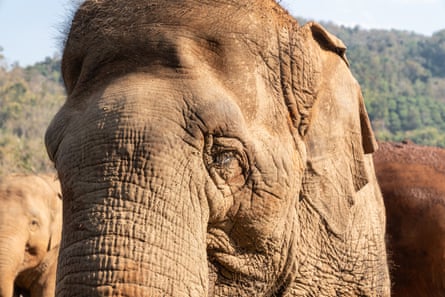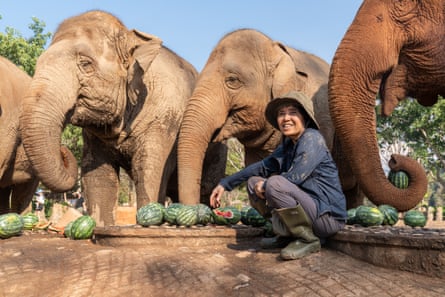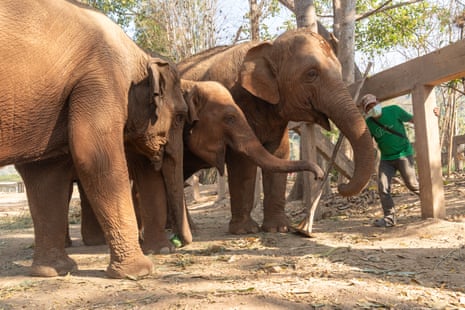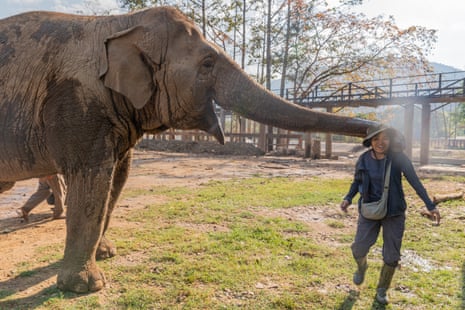Saengduean Lek Chailert was five years old when she saw an elephant for the first time. It was in chains, lumbering past her home in rural Thailand on its way to help loggers pull trees from the forest. Back then, she saw the giant mammals like everyone else – as animals that served humans. But that changed the day she heard a scream from the forest.
Chailert was 16 when she heard the terrible noise. She scrambled through the trees until she found the source: a bull elephant scrabbling in the mud as it tried and failed to drag a log out of a ditch. Every failed attempt was met with punishment from the loggers and mahout, the elephant keeper.
One would fire a sling shot at the animal, another stabbed it with a knife and a third jabbed a spike into the elephant’s leg. With each jab, the animal would let out a scream of pain.
“The elephant looked at me and I felt the fear and anger. I felt helpless and confused. My heart hurt a lot,” says Chailert. “I tried everything to get the screaming to stop but I was disturbing their work, so I had to go. I kept asking ‘why, why, why?’
“When I went back to my village, I could still hear the elephant when we were having dinner that night,” she says.
The incident changed the direction of Chailert’s life for ever. She was from a poor family – there was no electricity or school in her village – but she vowed to do something for the animals she loved.
Before a ban on logging in natural forests in Thailand in 1989, elephants were a key part of the industry. In the early 20th century, there were an estimated 100,000 elephants in Thailand. Thousands were worked to death or left with severe injuries from dragging enormous trees from the rainforest to roads, where they would be transported for lumber.
After the ban, many elephants were used by the country’s rapidly growing tourism industry to give performances and rides.
Working in a tourism agency in her early 20s, Chailert watched the change happen with horror. “There were many backpackers at that time. Camp owners were competing with each other for tourists,” she says.
“They would train their elephants to dance, ride a motorbike, play darts or hula hoop, walk on a rope or play a harmonica. This brought more suffering to elephants.”
It took Chailert a few attempts to fulfil her dream of finding a way to care for Thailand’s elephants. In 1996, she sold everything she had and borrowed money to set up an elephant sanctuary. She paid $30,000 for four hectares (10 acres) of land to provide a home to nine elephants.
She insisted that there would be no elephant rides or performances. Her family invested money to help but after disagreements over how to run the park, she left the project, taking the elephants with her.
Then, Chailert got lucky. National Geographic was filming a
documentary with the Hollywood star Meg Ryan about Thailand’s wild elephants, which were estimated to number 4,000 to 4,400 by 2023; Chailert and her newly released elephants featured in it.
In the US, a Texas couple Bert and Christine Von Roemer saw the TV programme and contacted Chailert, donating enough money to buy a 20-hectare parcel of land in the Mae Taeng district of northern Thailand, near Chiang Mai. In 2003, Elephant Nature Park was born.
Today, about 120 rescue elephants are at the park, which has grown to more than 1,000 hectares, home to a small fraction of the 3,900 or so domesticated elephants in the country. The sanctuary’s work has an enormous social media following on Instagram and Facebook.
Elephants arrive from all over Thailand. Chailert, now 64, sometimes travels for more than 50 hours with the animals after they are rescued.
“Some arrive with huge mental issues. Some stand like a zombie; some are aggressive, they swing their head back and forth. When they arrive, we do not allow our staff to use any tools or do anything that might make them feel threatened.
“We are gentle. We have to give them our love to make them trust us. We have to be patient,” she says.
New arrivals are almost always put into quarantine and slowly introduced to the herd. Over time, they are accepted. When their ears start to flap and their tails start to whirl, the elephants are happy, says Chailert.
“The priority is that every elephant has a family,” she says, showing the herd feeding in the forest on a screen.
Today, the conservation scheme is funded by visitors and volunteers who pay to work on the project. But despite the success of the sanctuary, Chailert fears for the future of Asian elephants, which she believes are decreasing in Thailand, despite official figures showing a steady increase in the population.
“Throughout Asia, many people are starting to hate elephants. Human-wildlife conflict is a big problem. Many died from being shot and poisoned” she says.
“Many have lost their habitat and water sources so they have to go to golf clubs and rice fields – places that don’t belong to them. So, people get angry and make the elephant into a monster. The future will depend on the government policy to resolve this,” she says.















